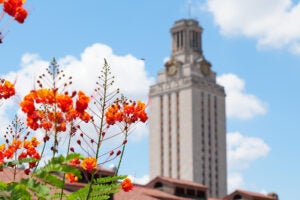AUSTIN, Texas—The University of Texas at Austin Tuesday (Nov. 16) announced that Herzog & de Meuron have resigned their commission as design architects for the planned Jack S. Blanton Museum of Art. The architects indicated that their decision was based on their judgment that it would not be practical to bridge differences over the interpretation of the project in the context of the Campus Master Plan. The plan was adopted by the UT System Board of Regents in 1996 to guide future development of the campus.
UT Austin President Larry R. Faulkner said that members of the UT community understand the basis for the decision and are in agreement that it would have been difficult to reach a jointly accepted concept of the new museum. “We, of course, regret that this partnership will not continue to the successful result that we had mutually envisioned. We continue to hold the firm of Herzog & de Meuron in the highest respect, and we wish its members continued distinction in their future work.”
Herzog & de Meuron representatives said that they are convinced that the process of consultation they have gone through with the UT System Board of Regents was productive in defining the parameters of the Blanton Museum. They expressed the hope that the results of the discussion will pave the way for further progress. “We do hope that by our resignation, we have opened the way for a successful resolution to the design of the Jack S. Blanton Museum of Art, and that the building will become the landmark the UT Community wishes it to be,” said the architects in a statement.
Faulkner added that, “the Regents and UT Austin remain committed to building a superb new museum and will expeditiously undertake selection of a new architectural design firm.”
Donald L. Evans, chairman of the UT System Board of Regents, said the decision by Herzog & de Meuron to withdraw from the Blanton Art Museum project is deeply disappointing. “Despite our disappointment, it is important to recognize that significant progress has been made in the planning process thus far,” he said.
“It is also clear that UT Austin and the Board of Regents remain firm in our commitment to the success of the museum. We want to ensure that the museum is a cultural institution that serves all of Texas; that it occupies a building of great style, character and integrity; and that it symbolizes the spirit, values and achievements of our beloved state. I am confident that we will move forward expeditiously and that we will present to the people of Texas an outstanding new cultural resource.
“Our vision for the museum continues to encompass three fundamental elements — that this will be a magnificent building in its own right, that it will be a fitting home to the University’s growing and renowned collections of art, and that it will reflect the fact that it occupies one of the most important sites in the state of Texas,” Evans said.
Herzog & de Meuron, based in Basel, Switzerland, served as design consultants under subcontract with Booziotis & Company, of Dallas, which has overall coordinating responsibility for architectural services on the museum project. The UT System Office of Facilities Planning and Construction will work with Booziotis & Company in negotiating a conclusion to the relationship with Herzog & de Meuron. The Dallas firm will complete program development in a form that can be transferred to the new design architects after they are appointed.
The firm of Herzog & de Meuron was awarded the commission to design the museum in December 1998. The museum has been scheduled to open in late 2002 and eventually will encompass approximately 150,000 square feet. Located at the intersection of Martin Luther King Boulevard and Speedway, the new building will enable the Blanton to exhibit a significant portion of its permanent collection, including the Suida-Manning Collection, featuring 700 works of European art from the Renaissance and Baroque periods.
Note to editors: A statement by Chairman Evans is below.
at the University of Texas at Austin
by Donald L. Evans
Chairman, The University of Texas System Board of Regents
November 16, 1999
The decision by the Swiss architectural firm of Herzog & de Meuron to withdraw from the Jack S. Blanton Art Museum project is deeply disappointing to me. Despite our disappointment, it is important to recognize that significant progress has been made in the planning process thus far. It is also clear that the University of Texas at Austin and the Board of Regents remain firm in our commitment to the success of the museum. We want to ensure that the museum is a cultural institution that serves all of Texas; that it occupies a building of great style, character, and integrity; and that it symbolizes the spirit, values, and achievements of our beloved state. I am confident that we will move forward expeditiously and that we will present to the people of Texas an outstanding new cultural resource. Our vision for the museum continues to encompass three fundamental elements — that this will be a magnificent building in its own right, that it will be a fitting home to the University’s growing and renowned collections of art, and that it will reflect the fact that it occupies one of the most important sites in the state of Texas.
I greatly appreciate the hard work, creativity, and vision which Herzog & de Meuron brought to this project. In fact, my own appreciation for their world-class vision only grew as I studied their work. I also remain grateful to all the other friends and organizations that have been involved in the development of the museum. The Houston endowment, Jack Blanton, Bernard and Audre Rapoport, James and Mari Michener, President Larry Faulkner, University faculty and committee members, the able staff of the University and the U. T. System, and so many others have worked tirelessly to help bring the dream of the museum to fruition. We have come a long way, yet we still have much left to accomplish. The Board of Regents looks forward to continuing to work with these and other individuals and groups in pursuit of our common goal — an art museum of uncommon distinction.
The University’s association with Herzog resulted in several fundamental achievements that will continue to be of value as we pursue the design of the museum with another firm. These achievements include working through a variety of what architects call “programming issues,” such as the various spaces within the building and their relationship, the size of the museum, and the range of possible layouts.
Most important, University officials and the Board of Regents have clarified in our own minds the extraordinary importance of the museum site, and we have a more comprehensive understanding of the basic questions that must be considered regarding the site. Particularly, we must address the question of how the museum’s location on the south boundary of the campus and at the northern end of Congress Avenue serves as a link between the University and the State of Texas Capitol building.
The site and the museum have vital significance within the context of the University’s overall master plan, including key elements such as adherence to the spirit of the traditional campus architecture. As the southern gateway to the campus, the site connects (literally and symbolically) the University with the Capitol building. This means the site also symbolizes the link between the University and all the people of Texas. Furthermore, the museum will be across the street from the state’s new Texas history museum, which is under construction at the corner of Congress Avenue and Martin Luther King Jr. Boulevard.
We have also gained a renewed and deepened appreciation for the importance of the art collections that will be housed in this building. The University holds in its care — on behalf of all the people of Texas and, indeed, on behalf of people everywhere — four extraordinary collections of art. These are the Suida-Manning Collection of European art, the Michener Collection of 20th century American art, the C.R. Smith Collection of Western American art, and the Duncan Collection of contemporary Latin American art. These and other important holdings will be brought together in one museum building for the first time.
At this location, therefore, we have a unique opportunity to build an art museum that will — by its formidable presence, the character of its design, and the content of its collections — symbolize the cultural and civic achievements and aspirations of the people of Texas. This museum will belong to the people of Texas, just as the University itself is the people’s treasure. It is the responsibility of the Board of Regents to ensure that the museum ultimately reflects this public trust.
Making the process work will require persistence, patience, and the continuing participation and cooperation of a wide variety of people and organizations. Knowing the Board, the University and its friends, and the people of Texas as I do, I have every confidence that the process will be successful.



